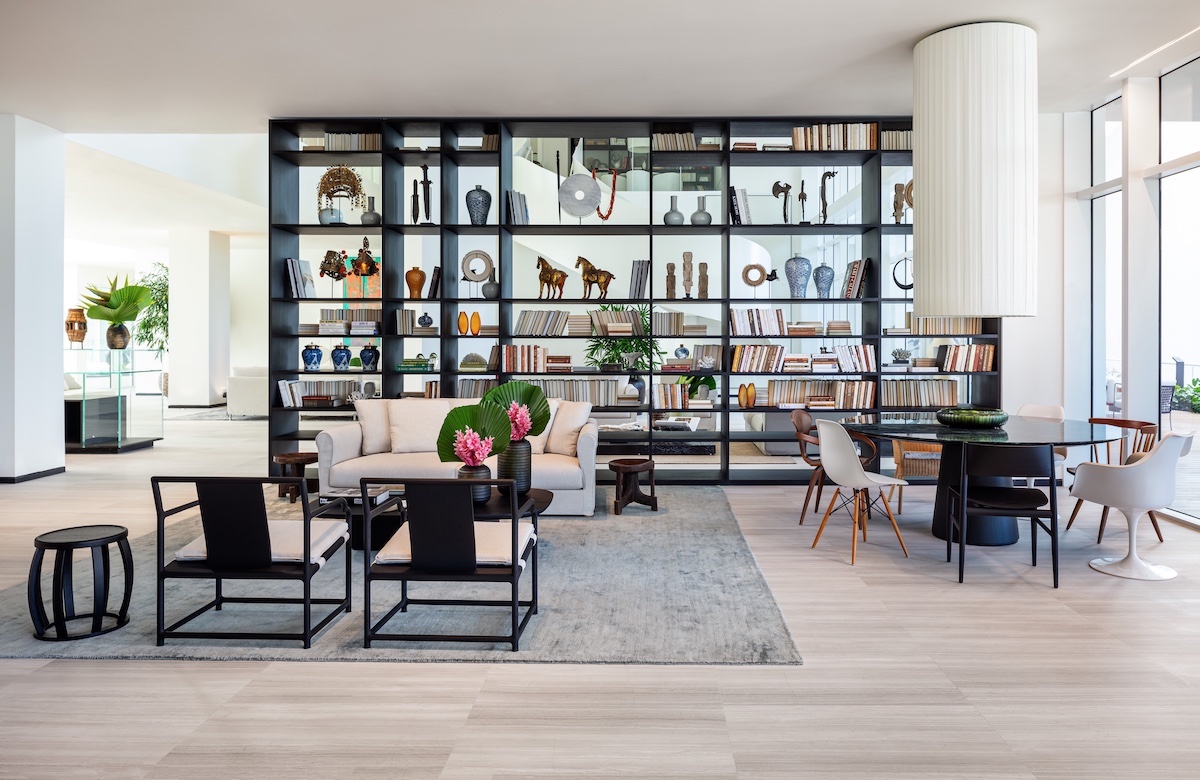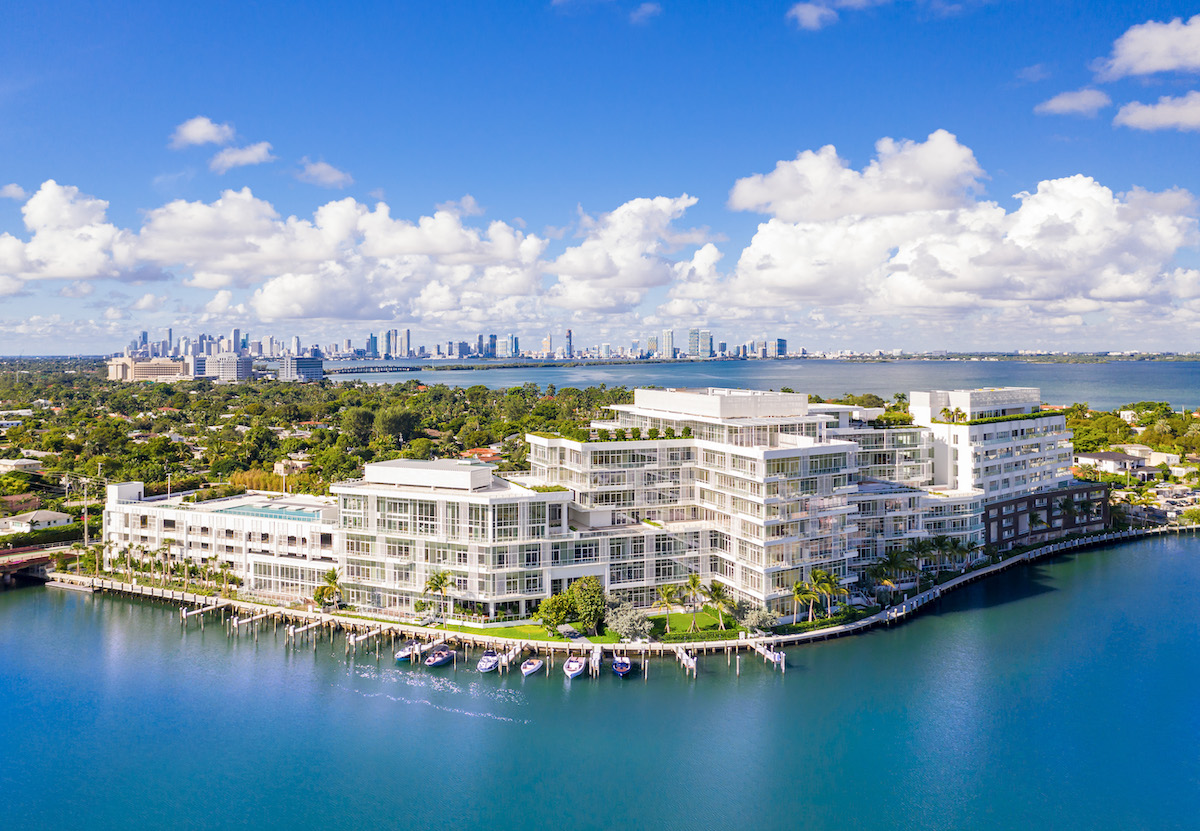In the 1920s, the King Cole Hotel helped put Miami Beach on the map as a popular tourist destination. Automotive industry pioneer and entrepreneur Carl Fisher developed the three-story, 60-room hotel to fulfill his vision of turning vacant land into an oceanfront winter getaway.
The hotel, which functioned as a military hospital during World War II, faced the wrecking ball in 1965 to make way for the property’s next occupant: the Miami Heart Institute. Over the next three decades, the hospital expanded its footprint on the 7.2-acre site to encompass six structures.
In 2000, Mount Sinai Medical Center acquired the Miami Heart Institute and ultimately consolidated its operations at the competing hospital system’s main campus about a mile away.
Real estate investment and development firm Lionheart Capital stepped in to purchase the deserted complex for $20 million in 2012, initiating the property’s third act as a luxury condo development. “It was a fair price, in an excellent location, and we felt confident we could transform the property into something truly special,” said Allison Greenfield, Partner at Lionheart Capital.

Residents have 24-hour access to a private art studio equipped with easels, sculpting surfaces, reference books, and supplies. Photo: Kim Sargent
But Lionheart faced some tough obstacles in converting the former hospital into condos—and starting from scratch wasn’t an option. “The site was overbuilt by about 600,000 square feet, so we would lose that space if we demolished the buildings,” said Greenfield. Rezoning the property to residential use would also limit the maximum building height of new construction to four stories.
Lionheart enlisted Stantec’s Miami practice to oversee the conversion process as architect of record. “The city was eager to approve the zoning change as long as the neighbors were in favor of it,” said Christina Villa, Senior Associate in Stantec’s Miami office.
ALSO SEE: Historic ‘skyscraper hospital’ in Brooklyn refashioned into 17 luxury condominium residences
Stantec staff met with residents of the surrounding Mid-Beach neighborhood, composed of single-family homes that range from historic 1920s structures to modern residences. “Most of the neighbors were ecstatic to hear that we were planning a condo development because it would decrease traffic and be more compatible with the neighborhood,” said Villa.
The intricate planning and design process involved reconfiguring the existing institutional building layouts to accommodate high-end residential units. “We stripped away everything that made the complex look like a hospital and brought it down to its bare columns, then started to carve out the massing of the buildings to make the floor plates work,” said Villa.
The process yielded a staggering 64 different unit layouts. “Unlike a typical South Florida multifamily building, where buyers choose a view and a stock layout, we essentially created 64 vertically stacked single-family homes,” said Greenfield.

The club room at the Ritz-Carlton Residences. Residents have access to the services of the Agatston Center for Private Medicine, led by Arthur Agatston, the cardiologist who created the South Beach Diet. Photo: Kim Sargent
Because the slabs between adjoining buildings did not align, the Stantec team planned each unit within the floor plates of its original structure, then created several new elevator lobbies that would transport residents directly up to their units.
The lower levels of the former hospital featured floor-to-floor heights of 12 to 14 feet, providing opportunities to create one-of-a-kind living spaces. “The price point for those lower floors is much higher than you would typically find in a condo tower because the units are so spectacular,” said Greenfield.
Miami's Ritz-Carlton Residences feature EUROPEAN ELEGANCE, MODERNIST AESTHETIC
To achieve its goals of establishing a European modernist design aesthetic, Lionheart engaged Italian architect and industrial designer Piero Lissoni as design architect. It was the first large-scale building project in the U.S. for the founder of Lissoni & Partners, an architecture and design studio with offices in Milan and New York.
Likening the property to “a new, small Portofino town,” Lissoni focused his attention on the building forms, façades, and public spaces. He also collaborated with Italian product designer Boffi to custom design the European-style kitchens and bathrooms in each unit.
When visitors enter the double-height main lobby, they have no clue they’re stepping into an environment that formerly housed an emergency department and surgical suites. Instead, they’re likely to be awed by the ironclad floating spiral staircase that anchors the space and the floor-to-ceiling glass wall that accentuates views of the adjacent private lake.

A floating spiral staircase marks the double-height main lobby, designed by architect Piero Lissoni, whose goal was to create the effect of a small fishing village in his native Italy. Photo: Kim Sargent
GUEST SUITES ADD A NEW OPTION TO THE MIX
The 678,000-sf Ritz-Carlton Residences, Miami Beach houses 111 condos that range in size from 2,000 sf to more than 10,000 sf and are priced from $2 million to $40 million. Also available for purchase are nine guest suites that function like hotel rooms and are positioned around an outdoor meditation garden. With the onset of COVID-19 lockdowns and work-from-home mandates, a few residents opted to convert these suites into private office environments.
Other outdoor amenity areas include a walking track that circumnavigates the property and a half-acre rooftop pool deck with private cabanas. Located atop the former hospital’s main parking structure, the expansive space offers panoramic vistas of the Atlantic Ocean, Biscayne Bay, and downtown Miami.
ALSO SEE: Designing multifamily housing for COVID-19
Residents can grow and pick their own fruits, vegetables, and herbs in the ecological food forest and community garden. They can even take advantage of a medical concierge service offered by the Agatston Center for Private Medicine, led by cardiologist Arthur Agatston, creator of the South Beach Diet.
A 36-slip private marina and captained day yacht on the neighboring Surprise Lake further distinguish the property from the region’s many other condo developments. Phase two, currently under construction, will add 15 single-family custom villas.
Since opening in February, the development is nearly sold out and has attracted an uncharacteristically large number of Florida-based residents. “I think it appeals to local buyers who may be leaving their house, but still want to maintain the individuality and specialness of their home environment,” said Greenfield. “The site is located in a beautiful, bucolic neighborhood that is perfect for those who really enjoy the South Florida lifestyle, and not just the weather.”

A postcard of the King Cole Hotel, built in 1920 by automotive industrialist Carl Fisher. The hotel was later converted to a hospital before being transitioned into residential use. Photo courtesy Stantec
PROJECT TEAM | THE RITZ-CARLTON RESIDENCES, MIAMI
DEVELOPER Lionheart Capital
DESIGN ARCHITECT | INTERIOR DESIGNER Lissoni & Partners
ARCHITECT OF RECORD Stantec
STRUCTURAL ENGINEER McNamara Salvia
CIVIL ENGINEER Kimley Horn
MEP ENGINEER Steven Feller, PE
BUILDING ENVELOPE CONSULTANT Paramount Consulting and Engineering
LANDSCAPE ARCHITECT Rhett Roy Landscape Architecture Planning
GENERAL CONTRACTOR Plaza Construction
Related Stories
| Aug 11, 2010
Gensler, HOK, HDR among the nation's leading reconstruction design firms, according to BD+C's Giants 300 report
A ranking of the Top 100 Reconstruction Design Firms based on Building Design+Construction's 2009 Giants 300 survey. For more Giants 300 rankings, visit http://www.BDCnetwork.com/Giants
| Aug 11, 2010
Parsons Brinckerhoff, Dewberry among nation's largest multifamily design firms, according to BD+C's Giants 300 report
A ranking of the Top 75 Multifamily Design Firms based on Building Design+Construction's 2009 Giants 300 survey. For more Giants 300 rankings, visit /giants
| Aug 11, 2010
ASHRAE introduces building energy label prototype
Most of us know the fuel efficiency of our cars, but what about our buildings? ASHRAE is working to change that, moving one step closer today to introducing its building energy labeling program with release of a prototype label at its 2009 Annual Conference in Louisville, Ky.
| Aug 11, 2010
RMJM unveils design details for $1B green development in Turkey
International architecture company RMJM today announced details of the $1 billion Varyap Meridian development it is designing in Istanbul’s new residential and business district, which will be one of the "greenest" projects in Turkey. The luxury 372,000-square-meter development on a site totalling 107,000 square meters will be located in the Atasehir district of Istanbul, which the Turkish government intends to transform into the country’s new financial district and business center.
| Aug 11, 2010
Urban Land Institute honors five 'outstanding' developments in Europe, Middle East, and Africa
Five outstanding developments have been selected as winners of the Urban Land Institute (ULI) 2009 Awards for Excellence: Europe, Middle East, and Africa (EMEA) competition. This year, the competition also included the announcement of two special award winners. The Awards for Excellence competition is widely regarded as the land use industry’s most prestigious recognition program.
| Aug 11, 2010
10 tips for mitigating influenza in buildings
Adopting simple, common-sense measures and proper maintenance protocols can help mitigate the spread of influenza in buildings. In addition, there are system upgrades that can be performed to further mitigate risks. Trane Commercial Systems offers 10 tips to consider during the cold and flu season.
| Aug 11, 2010
Brad Pitt’s foundation unveils 14 duplex designs for New Orleans’ Lower 9th Ward
Gehry Partners, William McDonough + Partners, and BNIM are among 14 architecture firms commissioned by Brad Pitt's Make It Right foundation to develop duplex housing concepts specifically for rebuilding the Lower 9th Ward in New Orleans. All 14 concepts were released yesterday.
| Aug 11, 2010
NAVFAC releases guidelines for sustainable reconstruction of Navy facilities
The guidelines provide specific guidance for installation commanders, assessment teams, estimators, programmers and building designers for identifying the sustainable opportunities, synergies, strategies, features and benefits for improving installations following a disaster instead of simply repairing or replacing them as they were prior to the disaster.
| Aug 11, 2010
MulvannyG2 Architecture wins “Best Mixed-use Development—Future” award
MulvannyG2 Architecture’s project, Aquapearl in Taipei, Taiwan, was honored by Cityscape Asia 2009 as the “Best Mixed-use Development -Future” on May 20, 2009 at the annual conference in Singapore.
| Aug 11, 2010
REDD and Corcoran Group Real Estate developing eco-friendly boutique condos in Brooklyn's Vinegar Hill
REDD and Corcoran Group Real Estate are developing 100 Gold, a 10-unit boutique condominium complex in Brooklyn's Vinegar Hill that consists of (6) one bedrooms, (2) duplex studios—one with a private yard, and (2) penthouses—duplex apartments with one bedroom and loft, and private terraces.







